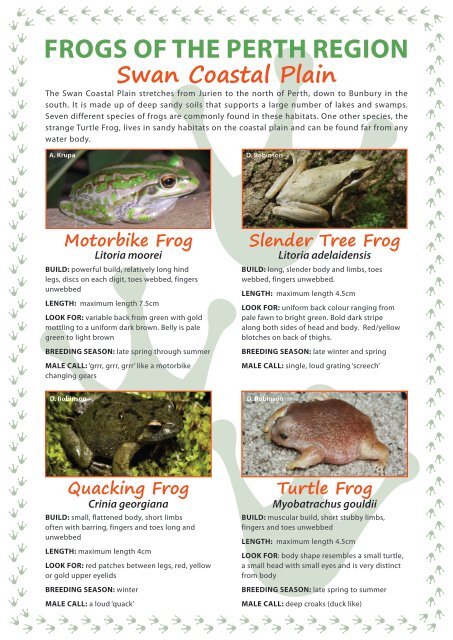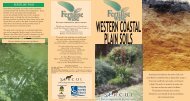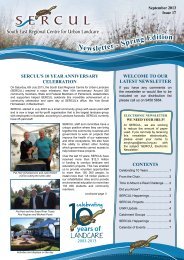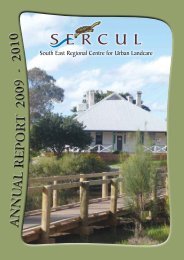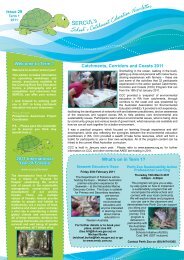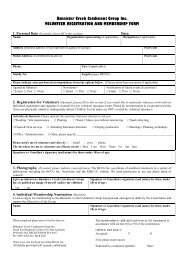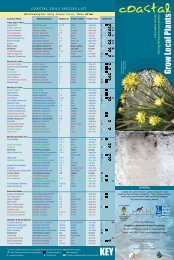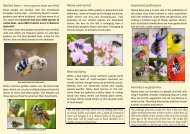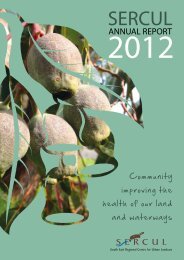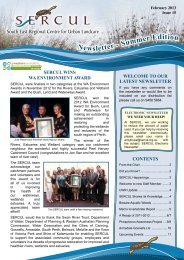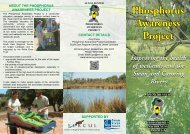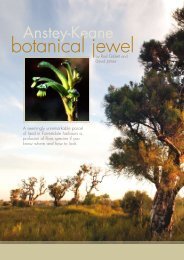Frogs of the Perth Region - Swan Coastal Plain.pdf - SERCUL
Frogs of the Perth Region - Swan Coastal Plain.pdf - SERCUL
Frogs of the Perth Region - Swan Coastal Plain.pdf - SERCUL
Create successful ePaper yourself
Turn your PDF publications into a flip-book with our unique Google optimized e-Paper software.
FROGS OF THE PERTH REGION<br />
<strong>Swan</strong> <strong>Coastal</strong> <strong>Plain</strong><br />
The <strong>Swan</strong> <strong>Coastal</strong> <strong>Plain</strong> stretches from Jurien to <strong>the</strong> north <strong>of</strong> <strong>Perth</strong>, down to Bunbury in <strong>the</strong><br />
south. It is made up <strong>of</strong> deep sandy soils that supports a large number <strong>of</strong> lakes and swamps.<br />
Seven different species <strong>of</strong> frogs are commonly found in <strong>the</strong>se habitats. One o<strong>the</strong>r species, <strong>the</strong><br />
strange Turtle Frog, lives in sandy habitats on <strong>the</strong> coastal plain and can be found far from any<br />
water body.<br />
A. Krupa<br />
D. Robinson<br />
Motorbike Frog<br />
Litoria moorei<br />
BUILD: powerful build, relatively long hind<br />
legs, discs on each digit, toes webbed, fingers<br />
unwebbed<br />
LENGTH: maximum length 7.5cm<br />
LOOK FOR: variable back from green with gold<br />
mottling to a uniform dark brown. Belly is pale<br />
green to light brown<br />
BREEDING SEASON: late spring through summer<br />
MALE CALL: ‘grrr, grrr, grrr’ like a motorbike<br />
changing gears<br />
Slender Tree Frog<br />
Litoria adelaidensis<br />
BUILD: long, slender body and limbs, toes<br />
webbed, fingers unwebbed.<br />
LENGTH: maximum length 4.5cm<br />
LOOK FOR: uniform back colour ranging from<br />
pale fawn to bright green. Bold dark stripe<br />
along both sides <strong>of</strong> head and body. Red/yellow<br />
blotches on back <strong>of</strong> thighs.<br />
BREEDING SEASON: late winter and spring<br />
MALE CALL: single, loud grating ‘screech’<br />
D. Robinson<br />
D. Robinson<br />
Quacking Frog<br />
Crinia georgiana<br />
BUILD: small, flattened body, short limbs<br />
<strong>of</strong>ten with barring, fingers and toes long and<br />
unwebbed<br />
LENGTH: maximum length 4cm<br />
LOOK FOR: red patches between legs, red, yellow<br />
or gold upper eyelids<br />
BREEDING SEASON: winter<br />
MALE CALL: a loud ‘quack’<br />
Turtle Frog<br />
Myobatrachus gouldii<br />
BUILD: muscular build, short stubby limbs,<br />
fingers and toes unwebbed<br />
LENGTH: maximum length 4.5cm<br />
LOOK FOR: body shape resembles a small turtle,<br />
a small head with small eyes and is very distinct<br />
from body<br />
BREEDING SEASON: late spring to summer<br />
MALE CALL: deep croaks (duck like)
D. Robinson<br />
A. Krupa<br />
Clicking Froglet<br />
Crinia glauerti<br />
BUILD: small, can be smooth or have ridges<br />
LENGTH: maximum length 2.5cm<br />
LOOK FOR: patterned with brown, black<br />
and grey markings, may have red lines along<br />
thighs<br />
BREEDING SEASON: winter through to<br />
early spring, will breed at any time after rain<br />
except mid summer<br />
MALE CALL: pea rattling in a can<br />
D. Robinson<br />
Western Banjo Frog<br />
Limnodynastes dorsalis<br />
BUILD: thick arms, poison glands above rear<br />
legs, fingers unwebbed, toes can be webbed<br />
LENGTH: maximum length 7.5cm<br />
LOOK FOR: red around groin, pale yellow<br />
line down centre <strong>of</strong> back, black/brown<br />
patches over back and limbs<br />
BREEDING SEASON: late autumn, winter<br />
and spring<br />
MALE CALL: single, very loud ‘bonk’<br />
J. Robert<br />
Squelching Froglet<br />
Crinia insignifera<br />
BUILD: small, can have bumps and ridges<br />
on <strong>the</strong> back, short limbs, fingers and toes<br />
unwebbed<br />
LENGTH: maximum length 3cm<br />
LOOK FOR: back usually complex pattern <strong>of</strong><br />
dark and light brown with grey blotches and<br />
or stripes<br />
BREEDING SEASON: winter<br />
MALE CALL: a low ‘squelch’<br />
Moaning Frog<br />
Heleioporus eyrei<br />
BUILD: powerful, robust with short limbs,<br />
fingers unwebbed, toes partly webbed<br />
LENGTH: maximum length 6.5cm<br />
LOOK FOR: brown and grey back mottled<br />
in dirty white or light grey. Yellow patch on<br />
flanks behind front limbs<br />
BREEDING SEASON: late autumn<br />
MALE CALL: a long drawn out moan<br />
Four o<strong>the</strong>r species (Crawling Toadlet, Sand Frog, Western Spotted Frog and Humming Frog) can be<br />
found in suburbs close to <strong>the</strong> Darling Scarp and in <strong>the</strong> <strong>Swan</strong> River Valley. These species are illustrated<br />
on <strong>the</strong> companion information sheet titled ‘<strong>Frogs</strong> <strong>of</strong> <strong>the</strong> <strong>Perth</strong> <strong>Region</strong>: The Darling Range’.<br />
More information can be found on <strong>the</strong> Alcoa Frog Watch website: frogwatch.museum.wa.gov.au/explore/frogwatch and<br />
<strong>the</strong> book ‘A Guide to <strong>the</strong> Reptiles and <strong>Frogs</strong> <strong>of</strong> <strong>the</strong> <strong>Perth</strong> <strong>Region</strong>’ by Bush, Browne-Cooper, Maryan and Robinson.<br />
Adapted from <strong>the</strong> Alcoa Frog Watch<br />
Information Sheet, published by <strong>the</strong><br />
Western Australian Museum, 2001<br />
© 2014, <strong>SERCUL</strong>


